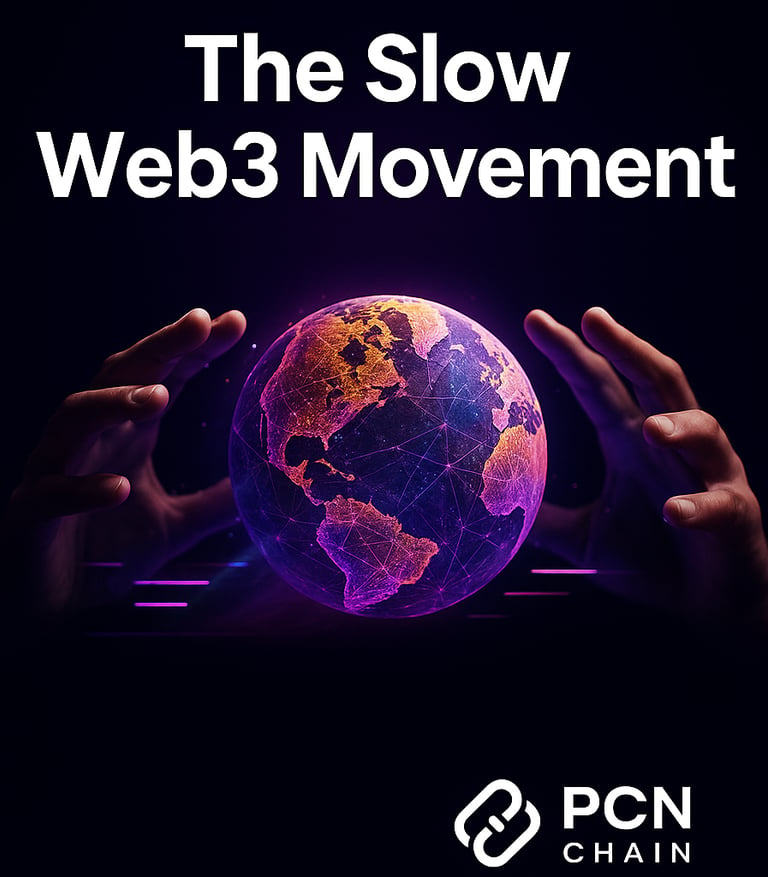The Slow Web3 Movement — Why Not Every Blockchain Needs to Move Fast
In crypto, everything seems to move at lightspeed. New projects launch daily. Tokens pump overnight. Entire ecosystems rise and fall in a matter of weeks


In crypto, everything seems to move at lightspeed. New projects launch daily. Tokens pump overnight. Entire ecosystems rise and fall in a matter of weeks. The industry prides itself on agility, on “moving fast and breaking things.” But maybe — just maybe — some things in Web3 are worth doing slowly.
Enter the idea of the “Slow Web3 Movement.” A quiet but growing philosophy that says: not everything needs to be a sprint. That in an industry obsessed with velocity, longevity might be the ultimate innovation.
⏳ The Hype Cycle vs. the Patience Curve
If you look at most blockchain projects, they tend to follow a pattern:
Initial launch with buzz
Token pumps
Temporary hype
Community explosion
Followed by… silence, burnout, or decline
Why? Because they tried to scale before they were ready. They optimized for short-term noise instead of long-term resilience. This is the “hype cycle” — and it's become a trap.
On the other side is the patience curve. Projects that grow quietly, focus on infrastructure, build real communities (not just Telegram bots), and choose consistency over chaos. These are the chains, tools, and apps that often seem invisible at first — but stick around when others fade.
🧠 Building for People, Not Charts
The problem with chasing speed is that you start building for charts — not for people. You optimize your token price, your TVL (total value locked), or your Twitter engagement, but forget that real users don’t care about any of that.
Real users care about:
Stability
Trust
Ease of use
Actual utility
That’s where projects like PCN Chain (and others like it) gain long-term relevance. Not because they rush, but because they choose to get the basics right. That means scalability that doesn’t break under stress. Bridges that don’t leak funds. Ecosystems that grow because they’re useful, not because they trend.
🌱 Organic Growth in a Synthetic Industry
Crypto is notorious for inflating metrics — fake wallets, paid press releases, shallow partnerships. But the Slow Web3 mindset values organic growth:
Communities that grow by word of mouth
Developers who build because they want to, not because they’re airdropped
Protocols that launch quietly, then gain traction over time
It may not get you on the front page of CoinDesk. But it will build something that actually lasts.
📖 A New Storytelling Paradigm
The slow movement also reshapes how projects tell their story. Instead of promising "10x gains" or “Ethereum 2.0 but better,” these projects talk about values:
Decentralization
Fair governance
Cross-chain cooperation
Economic sustainability
It’s less about shouting, and more about speaking clearly. Less about converting hype, and more about earning trust.
🏗 The Invisible Builders
Some of the most impactful work in Web3 is being done by builders you’ve never heard of — contributors to DAOs, open-source coders, protocol governors, and moderators who hold communities together when markets crash.
These people embody the Slow Web3 ethos. They’re not sprinting. They’re planting seeds, knowing they may not harvest the results for months — or years.
And they’re okay with that.
🧭 Why It Matters
PCN Chain doesn’t need to be “the fastest.” It doesn’t need to make headlines or force adoption. What it (and projects like it) do need is to build for the future, not for a price spike.
Because while markets fluctuate, and trends fade, one thing stays consistent:
People remember what worked when everything else broke.
🔮 Final Thought: The Best Tech Doesn’t Always Shout
If you think about it, the strongest foundations are often invisible. You don’t notice them because they don’t wobble. You don’t question them because they just work.
So maybe, in a world where everything moves fast, the real flex… is moving slow.